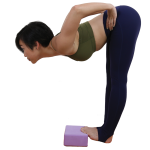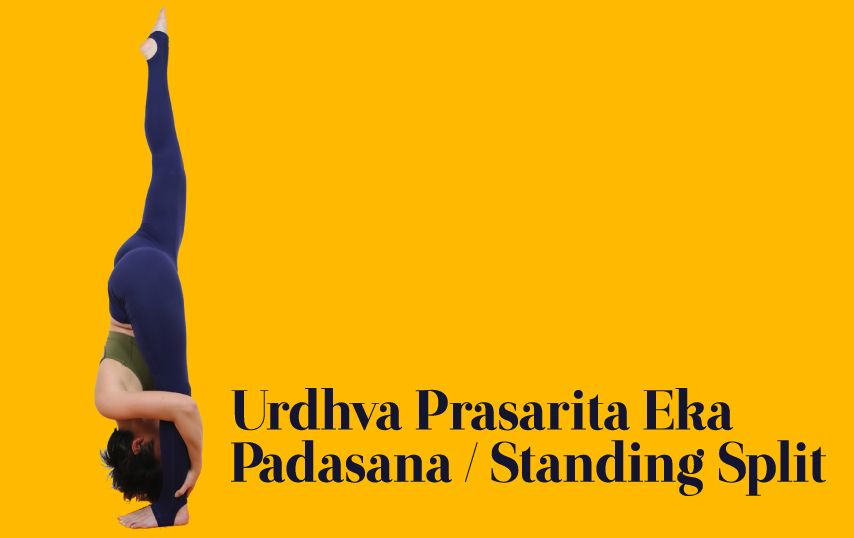This month’s featured pose is Urdhva Prasarita Eka Padasana, otherwise known as Standing Split. The name of the pose is derived from the terms “urdhva” or up/upwards, “prasarita” or wide-legged, “eka” or one, “pada” or foot, and “asana” or pose.
This is a deep forward bending pose that requires flexibility, strength and balance. When this pose is done properly, it can calm the mind by sending prana or energy to the neck and head, increasing Udana Vayu. As this is also a forward bend, the Svadhisthana Chakra in the sacrum and the Manipuraha Chakra in the abdomen area are activated, thus promoting proper digestion and a balanced reproductive system.
To achieve better results, attention should be given to both flexibility and strength. This pose embodies both qualities and creates a well-rounded practice. Two opposite muscles, the hamstrings and the quadriceps, work together in achieving this pose – a limitation in either of the two would make it challenging for the practitioner to come into this pose.
Chakra Awareness
Svadhisthana Chakra / Sacral
Practice Level
Advanced
Degree of Difficulty
(100 being most difficult)
90
Movement
Major Movements
Hip Flexion
A movement of bringing the thigh or top of the pelvis forward, decreasing the angle in between.
Knee extension
Straightening of the knee joint, i.e. moving the lower leg away from the back of the thigh.
Challenges faced during the practice
Balance
Hamstrings or hip tightness
Back extension
Chances of Injury
Falling while in the pose
Pulled Hamstrings
When doing physical activities such as running, kicking, or yoga poses like Urdhva Prasarita Eka Padasana, there is a chance that one of the hamstring muscles will be strained and suddenly stretched, causing the muscle to tear.
Contraindications
Existing hamstrings, back, ankle or hip injury
Athletes, specifically those who use a lot of lower body movement in sports, need to be cautious when trying this pose to avoid injuries related to overstretching the already agile lower body.
Major Muscles Involved
Hamstrings
Located at the back of the thigh, the hamstrings cross and act upon the hips and the knees. It partially controls the knee movement, avoiding any hyperextension of the knees.
Quadriceps
A large muscle group that includes the four prevailing muscles on the front of the thigh, which act as extensors of the knee joint. These muscles are engaged mainly in backward bending poses. The quadriceps is the antagonists to the hamstrings.
Iliopsoas
The combination of the iliac and psoas major muscles that make an important part of the hip flexors. Also known as the dorsal or inner thigh hip muscles, the iliopsoas work for the flexion of the hip.
Best Time to Practice
Afternoon or evening, when the body’s natural flexibility is present
………………….
Warm-up
In these warm-up poses, the aim is to give a deep stretch to the different parts of the lower body. It is essential that while in the pose, deep, mindful breaths must be taken to allow the energy to flow into the many muscles of the hip and legs. Hold each pose for a few breaths and depending on the pose, repeat the pose on the opposite side.
 Ardha Uttanasana / Standing Half Forward Bend variations
Ardha Uttanasana / Standing Half Forward Bend variations
- Come into Tadasana/Mountain Pose with the feet hip-width apart and hands on the waist. Roll the shoulders back and down to keep the chest open and to avoid hunching.
- Inhale and on exhale, engage the back of the thighs and lean into a half forward bend, bringing the chest lower than hip level. Extend the spine and chin and maintain the legs straight. Keep the body’s weight on the balls of the feet and keep the back arched.
- Hold the pose with mindful breathing and return to Tadasana.
Benefit: Stretches the hamstrings and extends the spine.
 Prop Use
Prop Use
- Place two blocks in front of the feet and step on the blocks, pressing the balls of the feet on the blocks and the heels on the floor. Avoid letting the feet roll outwards.
- Hold the waist, lengthen the torso by lifting the chest and roll the shoulders back.
- Inhale and on exhale, engage the back of the thighs and lean into a half forward bend, bringing the chest lower than hip level. Extend the spine and chin and maintain the legs straight. Keep the body’s weight on the balls of the feet.
- Hold the pose with mindful breathing and return to standing position, and then step off the blocks.
Benefit: Stretches the calves, promotes ankle flexion and extends the hamstrings.
More…
To read the full article please download our Asana Journal App or purchase Issue 161 May 2016.




















 Other
Other